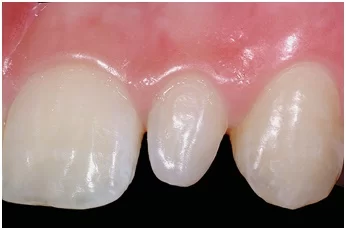Peg teeth are a dental condition where one or more teeth—most commonly the upper lateral incisors (the teeth right next to your two front teeth)—are smaller and cone-shaped instead of the usual rectangular shape. They’re sometimes also called peg laterals when they affect the lateral incisors.
What Causes Peg Teeth?
- Genetics – It’s usually hereditary.
- Developmental Issues – Can occur when the teeth don’t form properly.
- Syndromes – Rarely, peg teeth can be part of a genetic syndrome (like ectodermal dysplasia).
How to Fix Peg Teeth
There are several cosmetic and restorative options, depending on the severity and your goals:
1. Dental Bonding (Quick Fix)
- Composite resin is applied and shaped to make the tooth look normal.
- Pros: Fast, painless, and affordable.
- Cons: Less durable, may chip or discolor over time.
2. Porcelain Veneers (Most Popular)
- Thin custom-made shells that cover the front of the tooth.
- Pros: Natural-looking, durable, long-lasting.
- Cons: More expensive, requires some enamel removal.
3. Dental Crowns
- If the peg tooth is too small or weak, a crown may fully cover it.
- Pros: Very strong and protective.
- Cons: More invasive than veneers.
4. Orthodontics (Braces or Aligners)
- Sometimes needed before cosmetic work to move teeth into better positions.
- Especially if spacing is an issue around the peg tooth.
5. Implants or Bridges (If Tooth Is Missing or Needs Removal)
- Rare for peg teeth but can be an option in extreme cases.
Bonus Tips
- A consultation with a cosmetic dentist is the best starting point.
- Ask for a mock-up or digital preview of what your smile could look like.
- Consider combining treatments for a full smile makeover if needed.
Want help figuring out which option fits your situation best? You can tell me more about your smile goals, age, or whether you’ve seen a dentist yet.
More on What Causes Peg Teeth
Besides genetics, peg teeth can sometimes be associated with:
- Congenitally missing teeth – If you’re missing teeth (especially lateral incisors), peg teeth may appear where the full tooth didn’t develop properly.
- Developmental disturbances – Anything that disrupts normal tooth development, like trauma or illness during early childhood.
- Syndromic associations – Rare conditions like ectodermal dysplasia or Down syndrome can sometimes include peg-shaped teeth as a symptom.
In-Depth on Treatment Options
1. Dental Bonding (Best for younger patients or temporary solutions)
- Time: 1 visit
- Cost: Relatively inexpensive ($100–$500 per tooth)
- Lifespan: 3–7 years
- Ideal if you’re: Not ready for veneers or want to keep it low-cost and reversible.
2. Porcelain Veneers
- Time: Usually 2–3 visits
- Cost: $800–$2,500 per tooth
- Lifespan: 10–15+ years with good care
- Ideal if you’re: Looking for a natural, durable, long-term solution.
3. Crowns
- Typically used if the tooth is structurally weak or extremely small.
- More invasive than veneers (removes more natural tooth structure).
- Same material options: porcelain, ceramic, or porcelain-fused-to-metal.
4. Orthodontics Before Cosmetic Work
Sometimes, peg teeth are spaced too far from the front teeth, or the overall alignment of your teeth isn’t ideal. In that case:
- Braces or Invisalign can shift everything into place.
- Then, bonding or veneers can be applied for the finishing touch.
- Your dentist or orthodontist may suggest “interdisciplinary treatment” – working together to give you a perfect smile.
Cost Overview
| Treatment | Cost (Per Tooth) | Lifespan | Notes |
| Dental Bonding | $100–$500 | 3–7 years | Most affordable, quick fix |
| Porcelain Veneers | $800–$2,500 | 10–15+ years | Long-lasting, great aesthetics |
| Crowns | $900–$3,000 | 10–15+ years | Full coverage if needed |
| Orthodontics | $3,000–$8,000+ | Varies | Often paired with other work |
Note: Prices vary depending on location, dentist, and insurance.
What to Expect at the Dentist
Your first appointment will likely include:
- Consultation and smile analysis
- Photos and x-rays
- Discussion of options based on your budget, goals, and lifestyle
- Some dentists use digital mockups to show how your teeth could look
You can ask about:
- Payment plans or financing
- Whether insurance might cover part (rare for cosmetic-only, but some overlap with restorative needs)
Real Talk: Should You Fix Peg Teeth?
Yes, if:
- You’re self-conscious about your smile
- You want a more symmetrical, proportional look
- They’re affecting your bite, speech, or chewing
No rush, if:
- You’re not experiencing any discomfort or functional issues
- You’re fine with the natural variation in your smile (some people rock it!)
If you want, I can help you:
- Draft questions to ask your dentist
- Explore at-home smile preview apps
- Compare bonding vs. veneers side-by-side
Want to tell me more about your current smile, or are you thinking about a total makeover?
Conclusion:
Peg teeth are small, cone-shaped teeth—usually affecting the upper lateral incisors. While they don’t typically pose serious health risks, they can affect a person’s bite, oral hygiene, and self-confidence due to their unusual shape and size.
